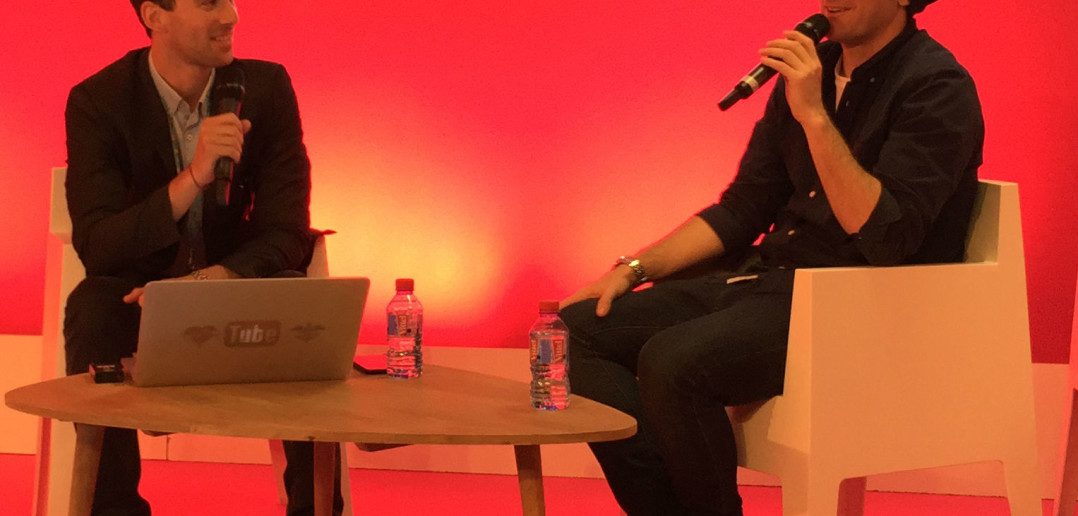Spanish YouTube star Luzu has nearly 1.6m subscribers to his main LuzuVlogs YouTube channel, with several spin-offs too. This afternoon at MIPTV, he took part in a Producers Toolbox session titled “How to be a YouTuber” moderated by David Ripert, head of YouTube Spaces EMEA at Google. On the agenda: advice and tips on the creative process required to build a following on YouTube.
Ripert started off with a 10-minute breeze through the different kinds of formats that exist on YouTube. The first format? “Everyone”. It’s a global platform to which everyone can upload content. “Our mission is for you to broadcast yourself, and that’s the ultimate definition of YouTube,” said Ripert. “You don’t have to stick to traditional TV or film formats to be successful on YouTube.”
He also mentioned accidental success. “A lot of these producers or brands think of making it on YouTube as having that one viral hit. Good idea? No.” Why? Because it’s much harder than people think to have a single video go viral. “We think it’s best to start consistently with a show, and be patient and start building the audience from zero.”
Ripert talked about conversations: vloggers. “We do think vlogging redefines what a format is on YouTube, and we think it’s similar to filmmaking, or at least a new version of filmmaking,” he said. The next format: explainers, from scientific education to cookery tutorials. “It’s something that’s very nutritious for the audiences, and delicious in that it’s for the better good… and it uses a lot of the search and discovery engine within YouTube.”
The next format: remixers. Cover artists, parodies and people remaking the main song from Frozen. “Letting fans remix videos that you have the rights to can be super-powerful for your content, and for becoming big on YouTube.”
There are filmmakers on YouTube, and brands too, who work with YouTube creators. “They have their own brand, so why not take advantage of that and collaborate with those creators?” said Ripert. He pointed to the mainstream channels too: famous musicians and popular broadcasters, who add archive material and/or create new videos for YouTube. And “the new mainstream: people like Vice are redefining what mainstream is,” he said, citing BuzzFeed as another example.
Ripert’s tenth format was “the next big thing” – something that suddenly crops up as a trend on YouTube and then travels around the world. In other words, there is always scope for new genres to come through.
At this point, he handed over to 29 year-old Luzu, who started in Spain but now lives in Los Angeles, running his three channels.
How did he get started? “I studied communication, so it was my field already: entertainment,” he said. “One morning I looked at the computer and decided I wanted a break,” he said. A course at UCLA in Los Angeles followed, then a job in the entertainment industry. “And in that job I started consuming a lot of YouTube in my free time,” he said.
The big advantage he sees about YouTube over TV: “You’re very passive when you consume [TV] and in YouTube you get the choice: the power of choosing where, when and what you want to watch every time.” Luzu decided he’d like to try to become a YouTube creator, filming in his house as a hobby. “I actually have a bigger audience in my channel than the TV company I used to work for!” he said.
What is Luzu’s creative inspiration? “For me, and from the beginning… it was like what am I missing? What would I like to see? A lot of people were concentrating on ‘what do people watch, what is the most famous and cool thing right now?’ Maybe that’s not the way to go because there is someone really good doing it already,” he said.
“Depending on the target that you’re trying to get to, there might be a different language to get to them. Kids like certain things, and teenagers other things, and adults different things,” he said. Gaming, for example, is a great way to reach younger people, so Luzu launched a gaming channel. Teenagers want more of a conversation, which is why they respond to strongly to vloggers. “And then adults want more content and more meat. That’s why I have three channels,” he explained.
Luzu makes great use of YouTube’s analytics, and compares them positively with the data that TV companies get. “I can know exactly who is watching, what age, what gender, from where… that’s incredibly useful for me, I can see how similar I am to those people, which is something that helps me a lot, because I am a very average person!”
Does he storyboard, write or do any re-production. “You could, but there is something about YouTube that is incredibly great: I have absolute freedom, I don’t have to go to a boss to ask for approval, to ask for permission. I have my cameras and my equipment, so I just do whatever I want,” he said. Luzu is currently uploading around 15 videos a week to his channels. “I usually get ideas from the most random moments: maybe I’m in the shower or go for a walk… then I find a way to turn really really small ideas into big things to reach a lot of people.”
He added that sometimes he can film a complicated video in an external location, then see a “simple conversation without cuts” get more views, so it’s not always easy to predict what kind of videos will be popular. Is there an advantage to having more glossy-looking content – for advertisers, for example? “Nowadays it’s not expensive to have equipment that will make your content look good,” said Luzu. “My vlogs looked a little bit better because they had depth of field and a little bit more texture.”
“We don’t need crews. The great thing about this is that formats are getting… we take budgets and everything to what you need. You really just need one or two people. I could do some of these formats by myself, but it still reaches hundreds of thousands of people and that’s because it’s based on personality and what you’re saying,” he continued.
What’s the best way to reach Luzu? Not email: he has “about 200,000” unread emails! But reaching out over Twitter, or through networks of fellow YouTubers. He also said that bringing something original to the table, be it musical or animation skills or an amazing location, that can help.
How about funding? “We do branded content, but I think the interesting thing is that for me, the main thing when I was still working in the production company and I opened my channel was ‘I need to do this at zero cost’,” he said. “There’s people who start with their phones nowadays. Flip it and you can do video. You are spending zero dollars and you can monetise those videos and when you grow you get money.”
Luzu talked about the importance of shareability: people share videos with friends in part to make themselves look cool, so that’s something any YouTuber needs to bear in mind. Is Luzu doing anything for other social media platforms? “I definitely spend a lot of time on social media,” he said. “There is a constant dialogue with the audience… here people are looking at someone in the eye when they are watching a vlogger, they are feeling connected and they want to talk to that person.”
He’s looking at Facebook at the moment and considering whether to make new videos for it, or simply post clips promoting his YouTube channel.. “What I wanna do is something which is attractive because Twitter multiplies. On Twitter every follower you have is a window to someone else” he said.
Luzu talked about mobile, and how he takes it into account. “One of the biggest things is that YouTube is consumed wherever. That’s one of the greatest things,” he said. “I don’t necessarily do it differently, but there are things you have to take into consideration: how you do the captions and things that appear on-screen… I put all my information in the description. But nowadays the devices are great enough that you don’t have to worry too much about it.”
“The greatest thing about this is we are defining a lot of things,” said Luzu. “The way people consume content is changing, and this way of doing content responds to the needs that they have rather than telling them how they should do it… YouTube passion is really contagious and really infectious.”
And he warned budding YouTubers not to get downhearted if it takes a while for their channel to get off the ground. “You have to keep in mind that it takes a long time. I spent a lot of time having 30 people watching my videos!” he said. “And then there is one moment where everybody shares it, and they go back to your old videos. So there isn’t a moment wasted along the way.”




